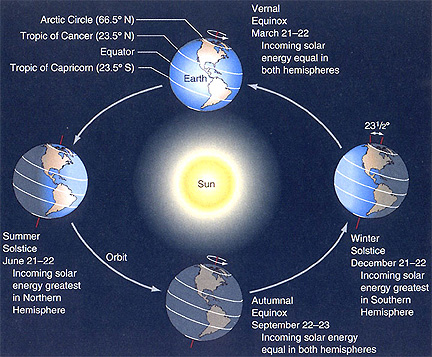[/caption]
The amount of the Sun’s energy falling at any point on the Earth depends on the angle of the Sun. This is reason why the seasons have different temperatures, and the polar regions are colder, on average than regions around the equator. Let’s take a look at why the angle of the Sun is so important, and how its change effects the Earth’s climate.
To understand how various parts of the Earth receive less energy, imagine holding a flashlight, and pointing straight at a piece of paper. Light comes out of the flashlight and forms a perfect circle on the paper. At this point, the energy from the flashlight is most concentrated in each square centimeter on the paper. Now imagine angling the paper so that the flashlight’s beam creates a big ellipse on the paper. The same amount of energy is coming out of the flashlight, but it’s being spread out across a much larger area of paper. Each square centimeter of paper is receiving less light than it was before.
Take this analogy to the Earth. When the Sun is directly overhead, like for people in the tropics, the maximum amount of energy is being soaked up by each square meter of Earth. This causes temperatures to rise. For the polar latitudes, the Sun is at a steep angle, so the same amount of energy from the Sun is falling over a much larger area.
During summer in the northern horizon, the Sun is at its maximum angle in the sky, and we get the most energy. But in the winter, the Sun is at a much steeper angle, and so we get less energy from the Sun. And this is why we experience different seasons – it’s all in the angle of the Sun.
Here’s more information from Universe Today about how the Earth has seasons. And Mars has seasons too.
Windows on the Universe has a great description of this. Here’s a handy tool you can use to calculate sunrise and sunset times, as well as the angle of the Sun.
We have recorded an episode of Astronomy Cast just about the Sun called The Sun, Spots and All.

